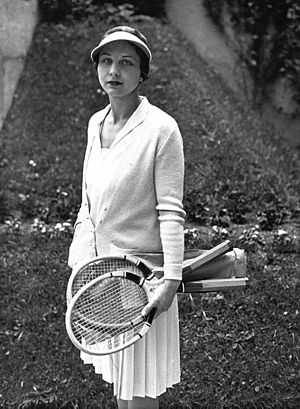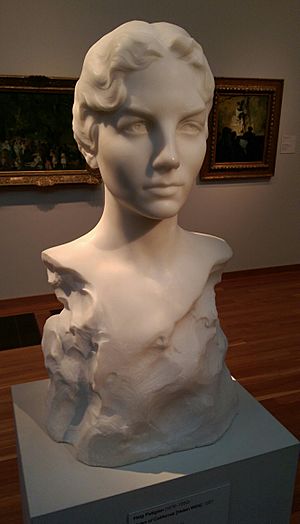Helen Wills facts for kids

Helen Wills in 1932
|
||||||||||||||
| Full name | Helen Newington Wills | |||||||||||||
|---|---|---|---|---|---|---|---|---|---|---|---|---|---|---|
| Country (sports) | United States | |||||||||||||
| Born | October 6, 1905 Centerville, California, US |
|||||||||||||
| Died | January 1, 1998 (aged 92) Carmel, California |
|||||||||||||
| Height | 5 ft 7.5 in (1.71 m) | |||||||||||||
| Retired | 1938 | |||||||||||||
| Int. Tennis HoF | 1959 (member page) | |||||||||||||
| Singles | ||||||||||||||
| Career record | 398–35 (91.92%) | |||||||||||||
| Highest ranking | No. 1 (1927) | |||||||||||||
| Grand Slam singles results | ||||||||||||||
| French Open | W (1928, 1929, 1930, 1932) | |||||||||||||
| Wimbledon | W (1927, 1928, 1929, 1930, 1932, 1933, 1935, 1938) | |||||||||||||
| US Open | W (1923, 1924, 1925, 1927, 1928, 1929, 1931) | |||||||||||||
| Doubles | ||||||||||||||
| Highest ranking | No. 1 (1924) | |||||||||||||
| Grand Slam doubles results | ||||||||||||||
| French Open | W (1930, 1932) | |||||||||||||
| Wimbledon | W (1924, 1927, 1930) | |||||||||||||
| US Open | W (1922, 1924, 1925, 1928) | |||||||||||||
| Grand Slam mixed doubles results | ||||||||||||||
| French Open | F (1928, 1929, 1932) | |||||||||||||
| Wimbledon | W (1929) | |||||||||||||
| US Open | W (1924, 1928) | |||||||||||||
| Team competitions | ||||||||||||||
| Wightman Cup | (1923, 1927, 1929, 1931, 1932, 1938) | |||||||||||||
|
Medal record
|
||||||||||||||
Helen Newington Wills (born October 6, 1905 – died January 1, 1998) was an American tennis player. She was also known by her married names, Helen Wills Moody and Helen Wills Roark. Helen won an amazing 31 Grand Slam titles in her career. This includes 19 singles titles, which is a huge achievement!
Helen Wills was the first American woman athlete to become famous worldwide. She even made friends with kings, queens, and movie stars. But she preferred to stay out of the spotlight. People admired her graceful movements and strong body. She helped change tennis fashion by wearing knee-length pleated skirts. Before her, players wore much longer skirts. She was also known for her special white visor.
Helen practiced against men to make her game stronger. She played a powerful game, hitting the ball deep and accurately. This often wore down her opponents. In 1926, she played a very famous match against Suzanne Lenglen. It was called the Match of the Century.
From 1927 to 1933, Helen had an incredible winning streak of 180 matches. In 1933, she even beat the eighth-ranked male player in the U.S. in a special match. Her record of eight wins at Wimbledon stood until 1990. That's when Martina Navratilova won her ninth title. Many experts, including famous tennis players, called Helen Wills the greatest female player ever.
Contents
Early Life and Tennis Beginnings
Helen Newington Wills was born on October 6, 1905. Her birthplace was Centerville, near San Francisco. She was the only child of Clarence A. Wills, a doctor, and Catherine Anderson. Her mother taught her at home until Helen was eight years old.
When Helen was eight, her father gave her a tennis racket. They practiced on dirt courts near the Alameda County Hospital. Helen became very interested in tennis after watching famous players like May Sutton and Maurice McLoughlin. In 1919, she joined the Berkeley Tennis Club. This was suggested by tennis coach William "Pop" Fuller. In 1920, she even practiced with Hazel Hotchkiss Wightman, a four-time U.S. Championships winner.
Helen went to the Anna Head School and later the University of California, Berkeley. She was a very good student and graduated from Berkeley in 1925.
Helen's Amazing Tennis Career
Helen Wills started playing in tournaments at age 13 in 1919. By the end of that year, she was the 7th ranked junior player in California. In 1921, she won the California State Championships. She was also ranked No. 1 in national juniors.
First Grand Slam Wins
In 1922, Helen reached the final of the U.S. Championships singles event. She was only 16 years old. She lost to 38-year-old Molla Mallory, a six-time champion. But Helen won her first Grand Slam title in doubles that year. She partnered with Marion Zinderstein Jessup.
In 1923, Helen won her first U.S. national singles title. She beat Molla Mallory in the final. At 17, she became the youngest champion at that time.
Olympic Gold and Wimbledon Debut
In 1924, Helen traveled to Europe for the first time. She played in the Wightman Cup and her first Wimbledon Championships. She reached the Wimbledon final but lost. This was her only loss in a Wimbledon singles event during her career. However, she won the doubles title at Wimbledon with Hazel Hotchkiss Wightman.
Helen then went to the 1924 Olympics in Paris. She won gold medals in both singles and doubles! Tennis was not an Olympic sport again until 1988. After the Olympics, she returned to the U.S. and won all three titles (singles, doubles, mixed doubles) at the U.S. Championships.
The "Match of the Century"
In 1926, Helen Wills played against the famous French player Suzanne Lenglen. This match at the Carlton Club in Cannes was called the Match of the Century. It was the only time they played each other in singles. Everyone was excited, and even King Gustaf V of Sweden watched. Lenglen won the match.
Soon after, Helen had an emergency appendectomy (surgery to remove her appendix). This made her miss the French Championships and Wimbledon that year.
Dominance at Grand Slams
After recovering, Helen Wills became almost unbeatable.
- In 1927, she won her first Wimbledon singles title and her fourth U.S. title. She was ranked No. 1 in the world for the first time.
- In 1928, she won the French Championships, Wimbledon, and the U.S. Championships. She was the first tennis player to win three Grand Slam singles titles in one year.
- She continued this amazing streak in 1929 and 1930, winning the French and Wimbledon titles again. She also won the U.S. Championships in 1929.
- In 1931, she won her seventh U.S. singles title.
- In 1932, she won the French and Wimbledon titles again.
Injury and Comeback
In 1933, Helen had to stop playing in the U.S. Championships final due to a back injury. This ended her 45-match winning streak at that tournament. She took more than a year off to recover.
In 1935, she made a great comeback at Wimbledon. She won her seventh Wimbledon title, even saving a match point in the final!
Retirement from Singles
Helen Wills didn't play much competitive singles tennis in 1936 and 1937. In 1938, she returned to Wimbledon and defeated her rival Helen Jacobs. This win gave her an incredible eighth and final Wimbledon title. After this, she retired from playing singles matches. She sometimes played in doubles or mixed doubles events later on.
Tennis Legacy and Achievements
Helen Wills had an amazing career record of 398 wins and only 35 losses. She had a winning streak of at least 158 matches where she didn't even lose a single set!
She won 19 Grand Slam singles titles:
- 7 at the U.S. Championships
- 8 at Wimbledon
- 4 at the French Championships
She also won 12 Grand Slam doubles and mixed doubles titles. Helen never played at the Australian Championships.
Helen was part of the U.S. Wightman Cup team many times. She helped her team win the cup in 1923, 1927, 1929, 1931, 1932, and 1938. Many experts consider her one of the greatest female tennis players of all time.
Awards and Honors
- In 1935, she was named Female Athlete of the Year by the Associated Press.
- She was inducted into the International Tennis Hall of Fame in 1959.
- In 1981, she joined the Bay Area Athletic Hall of Fame.
- Helen Wills appeared on the cover of Time magazine in 1926 and 1929.
- The New York Times called her "arguably the most dominant tennis player of the 20th century."
Playing Style and Personality
Helen Wills was known for her powerful tennis game. She hit strong forehand and backhand shots. She would hit deep shots to the left and right, making her opponents run all over the court. She was very focused and didn't show much emotion during matches. This earned her the nickname "Little Miss Poker Face."
Charlie Chaplin, the famous actor, once said that the most beautiful sight he had ever seen was "the movement of Helen Wills playing tennis."
What She Wore
Helen usually wore a white sailor suit with a pleated, knee-length skirt. She also wore white shoes and a short-sleeved top. A cerise-colored (bright pink) cardigan was often part of her outfit. Her most famous item was her signature white visor. She wore it almost always since she was a junior player. She liked it because it protected her eyes from the sun.
Personal Life and Interests
Helen Wills married Frederick S. Moody Jr. in 1929. They lived near the Berkeley Tennis Club. She also had a separate studio where she practiced painting and sketching. She divorced Moody in 1937 and later married Irish polo player Aidan Roark in 1939. She did not have any children.
Helen wrote a tennis coaching book called Tennis (1928). She also wrote her autobiography, Fifteen-Thirty: The Story of a Tennis Player (1937). She even wrote a mystery novel called Death Serves an Ace (1939).
Helen Wills was also an artist. She painted throughout her life and had exhibitions of her work in New York. She drew all the pictures in her tennis book. Her art was even part of the painting event at the 1932 Summer Olympics.
She met famous Mexican painter Frida Kahlo and her husband Diego Rivera in 1930. Rivera sketched Helen and wanted her to be the main figure in his mural Allegory of California. However, the committee for the mural didn't want a living person shown. So, Rivera changed the painting to make it not look exactly like Helen.
Helen Wills continued to play tennis into her 80s. She passed away on January 1, 1998. She left $10 million to the University of California, Berkeley. This money helped create the Helen Wills Neuroscience Institute, which studies the brain.
Images for kids
-
"Helen of California", a portrait sculpture by Haig Patigian, on display at the de Young Museum in San Francisco
Error: no page names specified (help).
- Performance timelines for all female tennis players who reached at least one Grand Slam final
- List of Grand Slam women's singles champions
- List of Grand Slam women's doubles champions
- List of Grand Slam mixed doubles champions
- List of Grand Slam related tennis records
- List of covers of Time magazine (1920s)
See also
 In Spanish: Helen Wills Moody para niños
In Spanish: Helen Wills Moody para niños










